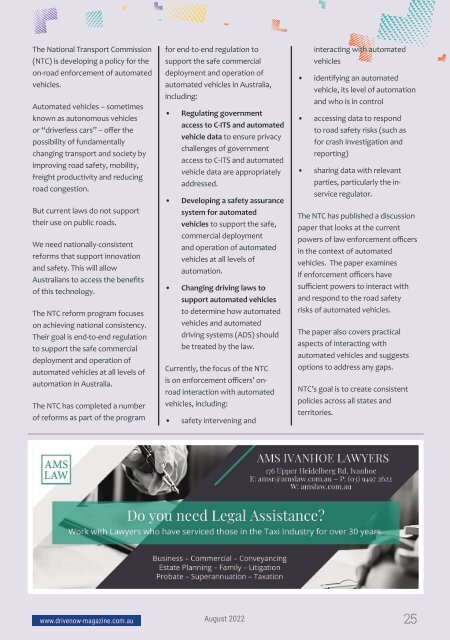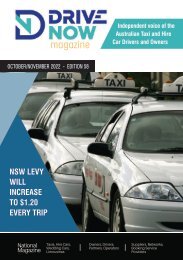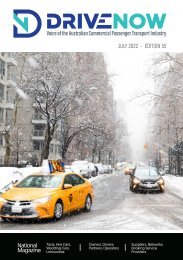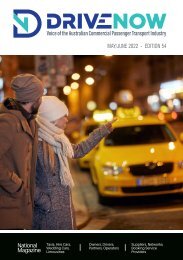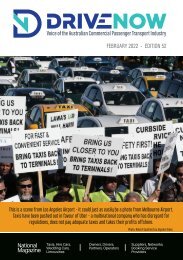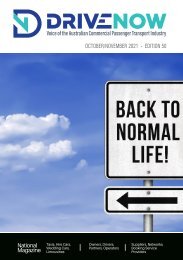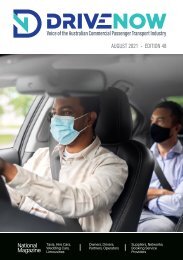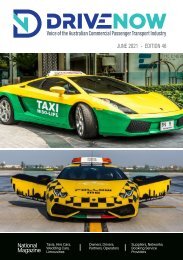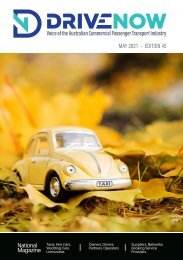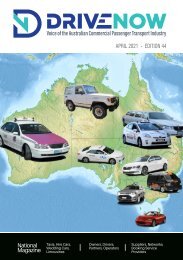DRIVE NOW August 2022
Australia's only Magazine for the Commercial Passenger Transport Industry. News and views for Drivers, Owners and Operators of Taxi, Hire Car, Limousine, Ride Share, Booked Hire Vehicles, Rank and Hail Cars.
Australia's only Magazine for the Commercial Passenger Transport Industry. News and views for Drivers, Owners and Operators of Taxi, Hire Car, Limousine, Ride Share, Booked Hire Vehicles, Rank and Hail Cars.
You also want an ePaper? Increase the reach of your titles
YUMPU automatically turns print PDFs into web optimized ePapers that Google loves.
The National Transport Commission<br />
(NTC) is developing a policy for the<br />
on-road enforcement of automated<br />
vehicles.<br />
Automated vehicles – sometimes<br />
known as autonomous vehicles<br />
or “driverless cars” – offer the<br />
possibility of fundamentally<br />
changing transport and society by<br />
improving road safety, mobility,<br />
freight productivity and reducing<br />
road congestion.<br />
But current laws do not support<br />
their use on public roads.<br />
We need nationally-consistent<br />
reforms that support innovation<br />
and safety. This will allow<br />
Australians to access the benefits<br />
of this technology.<br />
The NTC reform program focuses<br />
on achieving national consistency.<br />
Their goal is end-to-end regulation<br />
to support the safe commercial<br />
deployment and operation of<br />
automated vehicles at all levels of<br />
automation in Australia.<br />
The NTC has completed a number<br />
of reforms as part of the program<br />
for end-to-end regulation to<br />
support the safe commercial<br />
deployment and operation of<br />
automated vehicles in Australia,<br />
including:<br />
• Regulating government<br />
access to C-ITS and automated<br />
vehicle data to ensure privacy<br />
challenges of government<br />
access to C-ITS and automated<br />
vehicle data are appropriately<br />
addressed.<br />
• Developing a safety assurance<br />
system for automated<br />
vehicles to support the safe,<br />
commercial deployment<br />
and operation of automated<br />
vehicles at all levels of<br />
automation.<br />
• Changing driving laws to<br />
support automated vehicles<br />
to determine how automated<br />
vehicles and automated<br />
driving systems (ADS) should<br />
be treated by the law.<br />
Currently, the focus of the NTC<br />
is on enforcement officers’ onroad<br />
interaction with automated<br />
vehicles, including:<br />
• safety intervening and<br />
interacting with automated<br />
vehicles<br />
• identifying an automated<br />
vehicle, its level of automation<br />
and who is in control<br />
• accessing data to respond<br />
to road safety risks (such as<br />
for crash investigation and<br />
reporting)<br />
• sharing data with relevant<br />
parties, particularly the inservice<br />
regulator.<br />
The NTC has published a discussion<br />
paper that looks at the current<br />
powers of law enforcement officers<br />
in the context of automated<br />
vehicles. The paper examines<br />
if enforcement officers have<br />
sufficient powers to interact with<br />
and respond to the road safety<br />
risks of automated vehicles.<br />
The paper also covers practical<br />
aspects of interacting with<br />
automated vehicles and suggests<br />
options to address any gaps.<br />
NTC’s goal is to create consistent<br />
policies across all states and<br />
territories.<br />
www.drivenow-magazine.com.au<br />
<strong>August</strong> <strong>2022</strong><br />
25


